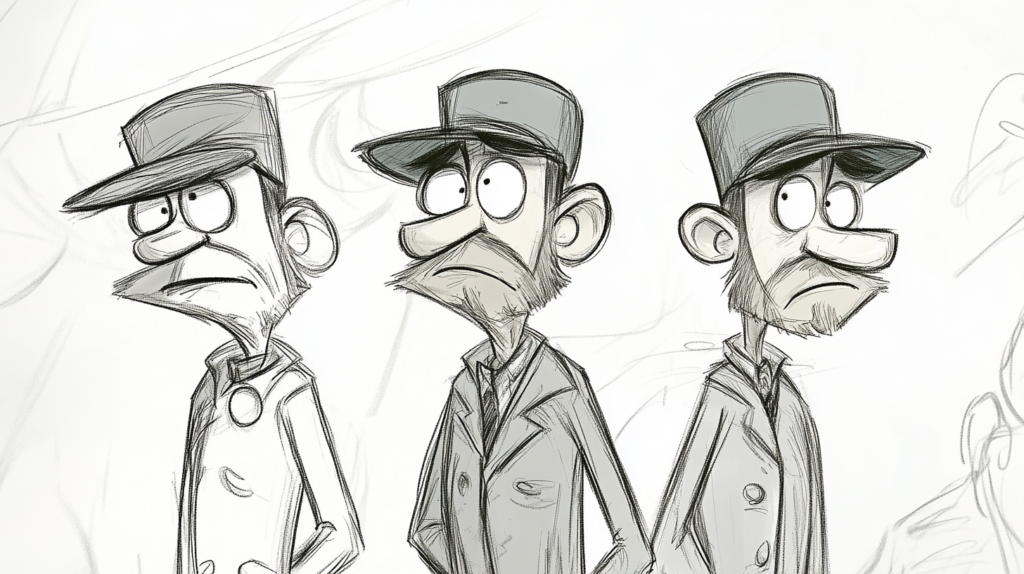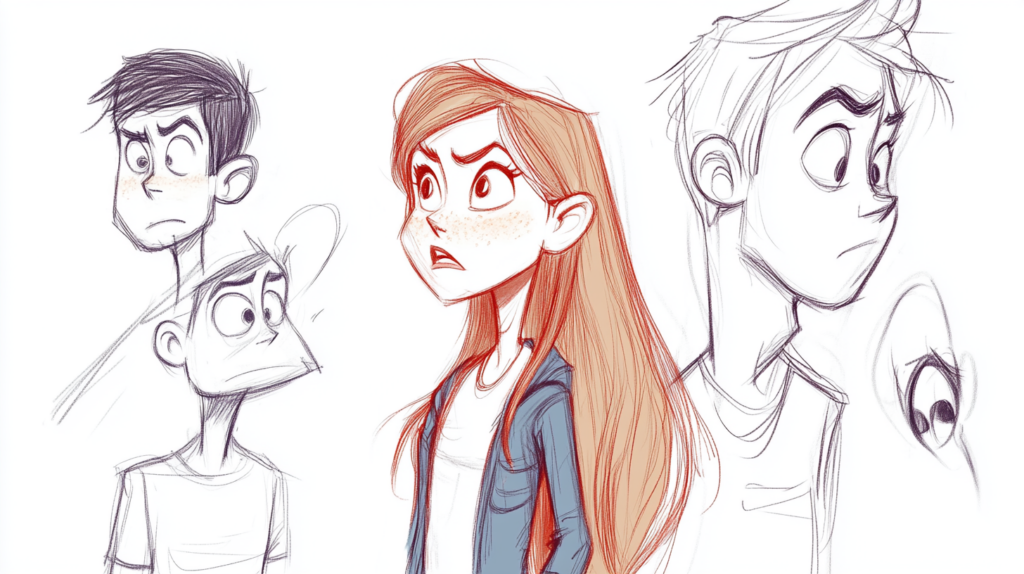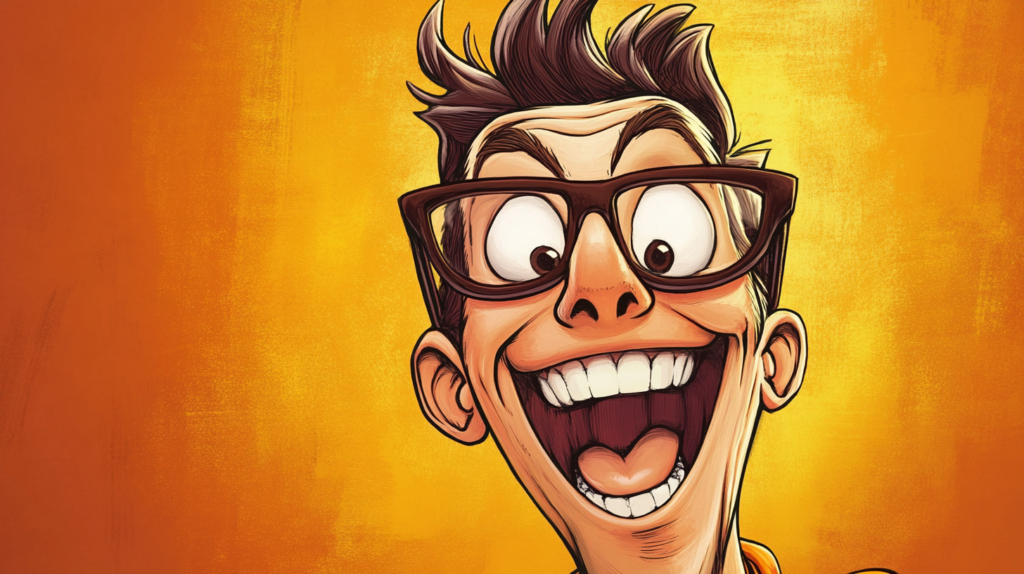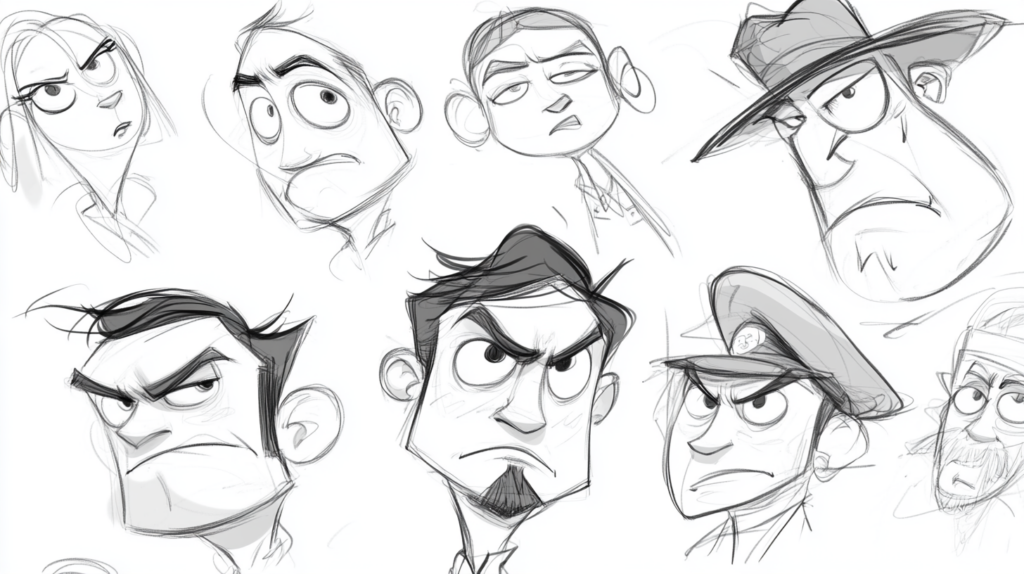Steps to Create a Funny Cartoon: Creating a funny cartoon involves combining humor with creative visuals to entertain and engage your audience. Whether you’re drawing a single-panel comic, a strip, or an animated short, the key to making it funny lies in your ability to craft clever jokes, relatable characters, and amusing situations. Here’s a step-by-step guide to help you create your own funny cartoon.
1. Develop a Concept
Brainstorm Ideas
Start by brainstorming ideas for your cartoon. Think about everyday situations, common frustrations, or quirky characters that could be turned into something humorous. Write down anything that comes to mind, no matter how silly it seems—often the most random ideas can spark the funniest cartoons.

Choose a Theme or Situation
Pick a theme or situation that lends itself well to humor. Some common themes include:
- Everyday Life: Observations about daily routines, work, or family life can be a goldmine for humor.
- Exaggeration: Take a normal situation and exaggerate it to absurd levels.
- Incongruity: Combine things that don’t normally go together for comedic effect.
- Puns and Wordplay: Clever wordplay or puns can add a layer of humor to your cartoon.
Think About the Audience
Consider who your audience is. Are you creating a cartoon for kids, teens, or adults? The humor you choose should resonate with the audience’s interests and sense of humor. For example, jokes about school might appeal to kids, while office humor might be better suited for adults.

2. Create Characters
Design Relatable Characters
Funny cartoons often feature characters that audiences can relate to. Create characters with distinctive traits, quirks, and flaws that can lead to humorous situations. Consider the following when designing your characters:
- Physical Appearance: Exaggerate certain features, like a large nose or wild hair, to make your character more visually amusing.
- Personality Traits: Give your characters strong personality traits that can be played for laughs, such as extreme optimism, clumsiness, or sarcasm.
- Relationships: Think about how your characters interact with each other. Odd-couple pairings, like a grumpy character with an overly cheerful one, can lead to funny exchanges.
Give Them a Unique Voice
Your characters should have their own distinct voice or way of speaking. This can add to the humor, especially when their dialogue contrasts with their actions or appearance. For example, a tiny character with a deep, booming voice can create an unexpected and funny moment.

3. Write the Joke or Punchline
Start with the Punchline
In humor, timing is everything, and the punchline is the key to making a cartoon funny. Start by coming up with a punchline or joke that you want your cartoon to deliver. The punchline is usually the last panel in a comic strip or the final moment in a single-panel cartoon, where the humor is revealed.
Build Up to the Punchline
Once you have your punchline, work backward to build up to it. Set up the situation in the first few panels (or the first part of a single panel), leading the audience in one direction, then deliver the punchline as a twist or unexpected turn. The build-up should create anticipation, setting the stage for the joke.
Use Wordplay and Puns
Wordplay, puns, and double meanings can be a great source of humor. Think of ways you can use language creatively to add layers to your joke. A well-timed pun or a clever turn of phrase can make your cartoon even more memorable.

4. Sketch the Cartoon
Start with Rough Sketches
Begin by sketching out your cartoon in rough form. Don’t worry about making it perfect at this stage—focus on getting the basic idea and layout down. Start with simple shapes and stick figures to plan out where each character and object will be placed.
Plan the Composition
Think about the composition of your cartoon. The placement of characters, speech bubbles, and background elements should guide the viewer’s eye through the cartoon, leading them naturally to the punchline. Keep the layout clean and uncluttered, so the joke is easy to follow.
Consider Facial Expressions and Body Language
Facial expressions and body language are crucial in conveying humor. Exaggerate your characters’ expressions to match the mood of the joke—wide eyes for surprise, a smirk for sarcasm, or a frown for disappointment. Body language can also add to the humor, like a slumped posture for a defeated character or a dramatic pose for an overconfident one.

5. Add Dialogue and Text
Write Dialogue in Speech Bubbles
Once your characters are sketched out, add dialogue using speech bubbles. Keep the dialogue short and to the point—brevity is key in humor. The speech bubbles should be placed in a way that doesn’t obscure important parts of the drawing but still guides the reader through the joke in the correct order.
Use Font and Style to Enhance Humor
The style of the text can also contribute to the humor. You might use bold or italicized text for emphasis or a different font for certain characters to reflect their personality. For example, a spooky or mysterious character might speak in a jagged, eerie font.
Incorporate Sound Effects
If your cartoon involves an action, consider adding sound effects to enhance the humor. Words like “BAM!”, “ZAP!”, or “SPLAT!” can make the scene more dynamic and fun. Be playful with the size and style of these sound effects—they should stand out and draw attention.

6. Refine and Finalize the Drawing
Inking the Drawing
Once you’re happy with your rough sketch and dialogue, go over your drawing with ink or a darker pencil to finalize it. Inking adds contrast and makes your cartoon look polished and professional. If you’re working digitally, this step can be done using digital inking tools in your drawing software.
Add Color
Adding color can bring your cartoon to life and make it more visually appealing. Use bright, bold colors to highlight important elements and keep the mood light and fun. If your cartoon is black and white, consider adding shading or textures to give it depth.
Clean Up the Final Drawing
Erase any unnecessary lines or adjust elements that don’t quite work. This is your chance to fine-tune the details, ensuring everything looks clean and that the joke is clear. If you’re working digitally, you can use editing tools to fix any mistakes or refine the composition.

7. Test the Humor
Show It to Others
Before you consider your cartoon complete, show it to friends, family, or colleagues to see if they find it funny. Sometimes, what’s hilarious in your head might not come across as intended to others. Getting feedback can help you fine-tune the joke and ensure it lands well with your audience.
Be Open to Tweaks
If the humor isn’t coming through as strongly as you’d like, don’t be afraid to make tweaks. Adjust the punchline, change a character’s expression, or reword the dialogue. Small changes can often make a big difference in the effectiveness of your joke.

Post on Social Media
Once you’re satisfied with your funny cartoon, share it on social media platforms like Instagram, Twitter, or Facebook. These platforms are great for reaching a wide audience and getting instant feedback. Use hashtags relevant to cartoons and humor to attract more viewers.
Create a Series
If your cartoon is well-received, consider creating a series featuring the same characters or themes. A series allows you to develop running gags, build character personalities, and establish a regular audience.
Submit to Publications
If you’re particularly proud of your work, consider submitting your cartoon to Toons Mag, magazines, newspapers, or online publications that feature humor or cartoons. Getting your work published can be a rewarding experience and a great way to reach a broader audience.
The Art of Creating a Funny Cartoon
Creating a funny cartoon is both an art and a science. It involves a blend of creative thinking, clever writing, and artistic skill. By following these steps—developing a concept, creating relatable characters, writing a punchy joke, and refining your artwork—you can craft a cartoon that not only entertains but also leaves a lasting impression. Remember, humor is subjective, so don’t be discouraged if your first attempts don’t hit the mark. Keep experimenting, learning, and most importantly, having fun with the process. After all, the best cartoons come from a place of joy and creativity.
Frequently Asked Questions about Steps to Create a Funny Cartoon
What are the initial steps to creating a funny cartoon?
- Conceptualize: Start by brainstorming ideas that can serve as the basis for humor. Consider everyday situations, current events, or exaggerated scenarios that could be turned into a comedic story.
- Character Development: Create unique and relatable characters with distinct personalities and quirks that can drive the humor in your cartoon.
- Write a Script: Develop a script or outline that includes dialogue, jokes, and the overall plot. Ensure the humor is well-paced and appropriate for your target audience.
How do you come up with funny ideas or jokes for a cartoon?
- Observe and Exaggerate: Look at real-life situations and exaggerate elements to make them humorous. Observational humor often works well in cartoons.
- Play with Wordplay: Use puns, double entendres, and witty dialogue to create comedic moments.
- Test and Refine: Share your ideas with others to gauge their reactions. Refine your jokes based on feedback to enhance their effectiveness.
What role do character design and expression play in making a cartoon funny?
- Character Design: Characters should have distinctive features and expressions that enhance their comedic impact. Exaggerated physical traits and outfits can add to the humor.
- Expressions and Reactions: Facial expressions and body language are crucial for conveying the humor in your cartoon. Use exaggerated expressions to highlight comedic moments and reactions.
How can you use visual elements to enhance the humor in your cartoon?
- Exaggeration: Amplify actions, reactions, and features to enhance the comedic effect. For example, characters might have overly dramatic reactions to minor events.
- Timing: Proper timing and pacing in your visuals can amplify the punchline. Use pauses, speed changes, or sudden shifts to build up to the humor.
- Visual Gags: Incorporate visual jokes or gags that complement the dialogue and add an extra layer of humor.
What are some common pitfalls to avoid when creating a funny cartoon?
- Overcomplicating Jokes: Keep humor simple and clear. Overly complex jokes or references can confuse the audience.
- Clichés: Avoid relying on overused jokes or stereotypes. Strive for originality to keep your cartoon fresh and engaging.
- Inconsistency: Ensure that the humor fits with the overall tone and style of the cartoon. Inconsistent humor can disrupt the flow and impact.
How do you ensure your cartoon’s humor is appropriate for your target audience?
- Know Your Audience: Tailor your humor to the preferences and sensitivities of your target demographic. Consider factors like age, cultural background, and interests.
- Test Your Material: Share your cartoon with a sample of your target audience to get feedback on the humor’s effectiveness and appropriateness.
- Stay Updated: Be aware of current events and cultural trends to ensure your humor remains relevant and respectful.
What are some techniques for refining and improving the humor in a cartoon?
- Review and Edit: Revisit your script and visuals to fine-tune jokes and timing. Look for ways to enhance punchlines or clarify setups.
- Seek Feedback: Get opinions from peers or mentors who can provide constructive criticism and suggestions for improvement.
- Study Successful Cartoons: Analyze successful funny cartoons to understand what works and incorporate similar techniques into your own work.
How do you balance humor with storytelling in a cartoon?
- Integrate Humor Naturally: Ensure that humor is woven into the storyline and character interactions, rather than feeling forced or out of place.
- Character Consistency: Keep characters consistent in their behavior and dialogue. Their comedic traits should align with their roles in the story.
- Plot Progression: Use humor to advance the plot and character development, rather than detracting from it. Ensure that jokes enhance rather than overshadow the narrative.
By following these steps and guidelines, you can create a funny cartoon that resonates with your audience and delivers effective humor.
This post was created with our nice and easy submission form. Create your post!










One Comment